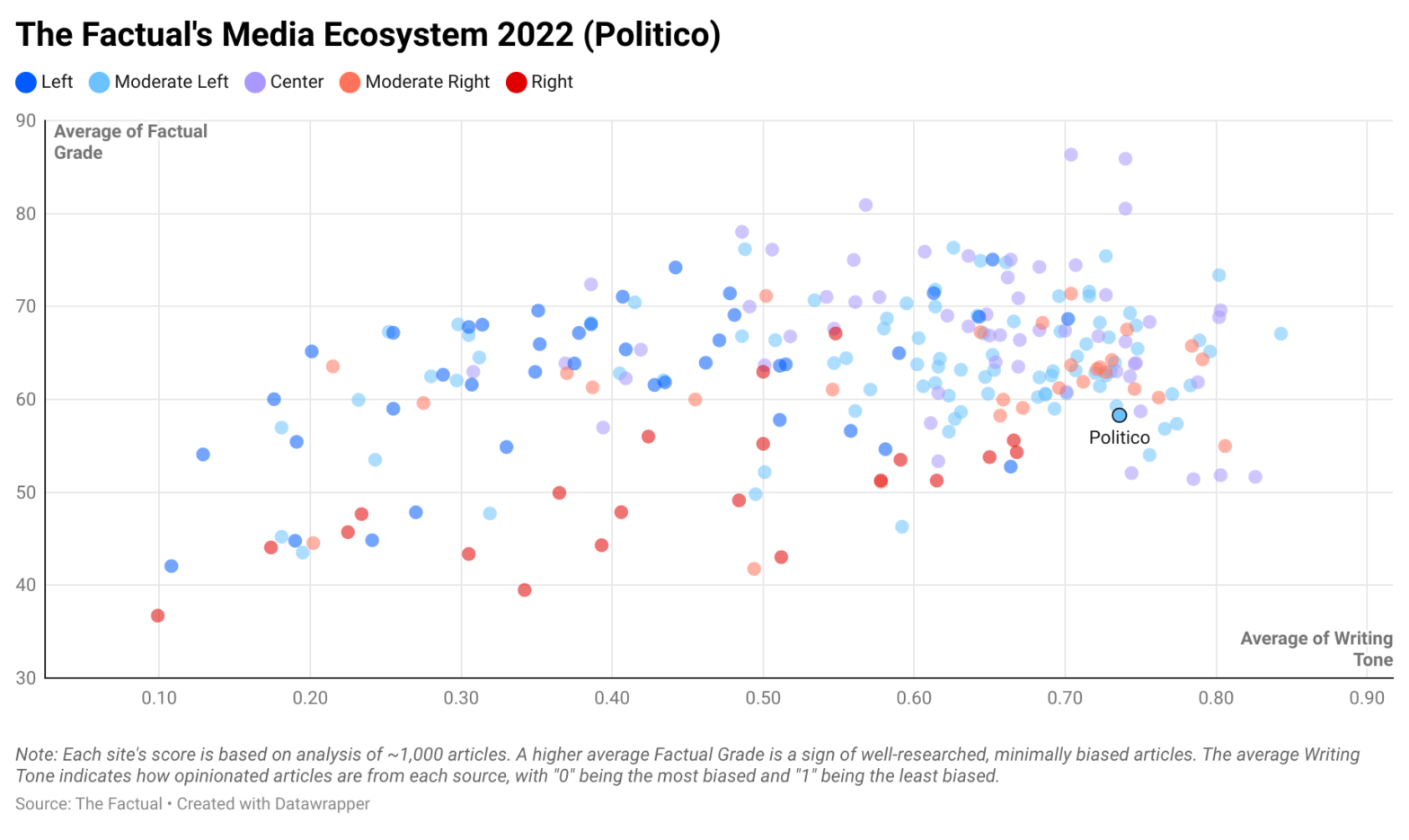Politico has risen from upstart to a key news source in Washington, recently selling for $1 billion. The media outlet seeks to be the “dominant source for news on politics and policy,” using “reliable information, nonpartisan journalism and real-time tools [to] create, inform and engage a global citizenry.” Does it deliver on this mission of being factual and unbiased?
How Does The Factual Rate News Sources?
The Factual analyzes more than 10,000 news stories every day to help readers find the most informative, least-biased articles. Our news-rating algorithm scores each article along four metrics: (1) cited sources and quotes, (2) publication history, (3) writing tone, and (4) author expertise. These scores combine in a weighted average we call a Factual Grade, which ranges from 0–100%. (See our How It Works page to learn more about our algorithm.)
For this study, we analyzed ~1,000 articles each from 240 news sources. The average Factual Grade for the entire dataset was 62.5%. Based on these averages, we can compare the performance of news sites across the media ecosystem. The entire dataset can be explored in greater detail here.
How Factual Is Politico?
Politico scored an average Factual Grade of 58.3%, placing it in the 23rd percentile of our dataset. Politico has many articles that are consistent in terms of sourcing, writing tone, and author expertise. However, numerous articles lacked cited evidence or used heavily opinionated language, particularly when covering politics, leading to lower overall scores.
Like any news source, scores for articles from Politico varied widely based on factors like cited evidence and writing tone. For example, some scored nearly 80%, while others scored below 50%.
Please check your email for instructions to ensure that the newsletter arrives in your inbox tomorrow.
One of the metrics The Factual uses is the Writing Tone, which measures how opinionated the writing is in an article. For this metric, the algorithm looks for signs of subjective commentary (e.g., first person pronouns and unnecessary adverbs), as well as the emotional nature of selected words, and sees how prevalent they are for a given length of text. More neutral text receives higher ratings, with “0” being the most opinionated and “1” being the most neutral.
Politico had an average Writing Tone score of 0.74, placing it in the 85th percentile in our dataset for this metric. This suggests that articles from Politico often use highly neutral language. This can be seen in article titles such as “China sends warships to surround Taiwan amid Pelosi visit” and “Youngkin will pursue 15-week abortion ban in Virginia.”
What Is Politico's Political Bias?
The Factual classifies news sites by political bias as either Left, Moderate Left, Center, Moderate Right, or Right. This classification comes from third-party assessments from media bias organizations such as AllSides and Media Bias/Fact Check (MBFC). Based on this data, The Factual assigns Politico a Moderate Left bias.
AllSides rates Politico as having a “Lean Left” bias, based on survey data and over 52,417 ratings from the community. According to an AllSides survey of 2,285 people in 2020, “The average rating for Politico from each bias group — people who identified themselves as Left, Lean Left, Center, Lean Right, or Right — was also Lean Left.” AllSides previously assigned Politico a “Center” rating, but this was adjusted to “Lean Left” in 2018 based on new data.
Meanwhile, Media Bias/Fact Check gives Politico a “Left-Center” rating, as well as a “High” rating for factual reporting. “Left-Center” sources “often publish factual information that utilizes loaded words to favor liberal causes,” according to Media Bias/Fact Check. They further acknowledge accusations against Politico of being both too liberal and too conservative, but also highlight it’s majority-liberal audience and “a more left-leaning bias in both story selection and editorial positions.”
Past controversies can also be a good indicator of the level of bias present at a publisher. In January 2021, Politico received backlash for publishing a piece by conservative commentary Ben Shapiro. Readers and staff widely disliked the move, as evidenced by a Politico letter signed by more than 100 staffers, but the editorial team stuck with their decision, stating “We’re not going to back away from having published something because some people think it was a mistake to do so.”
Who Owns Politico?
Politico began as a small operation in 2007 with the help of founder Robert Allbritton, one of America’s “lesser-known media moguls.” However, Axel Springer, Europe’s largest publishing house, purchased Politico in its entirety in August 2021. Axel Springer owns numerous other media outlets, including Business Insider and major German newspapers such as Die Welt and Bild. Axel Springer’s potential influence on bias is difficult to assess. The acquisition is very recent and it owns both liberal and conservative publications.
Please check your email for instructions to ensure that the newsletter arrives in your inbox tomorrow.
How to Mitigate Bias
News articles are bound to have bias because all authors have some frame of reference within which they describe a story. Political bias ratings are helpful in understanding this framing. However, it can be more beneficial to know how factual an article is based on quantifiable metrics that can be seen across the media ecosystem, such as cited evidence, author expertise, and writing tone. This is what The Factual ascertains.
Reading several, highly rated articles from across the political spectrum helps counter the bias of any news source or story. To have the day’s most factual news stories delivered to your inbox every morning, subscribe to our daily newsletter.
Article published on September 21, 2022 to reflect new data.

